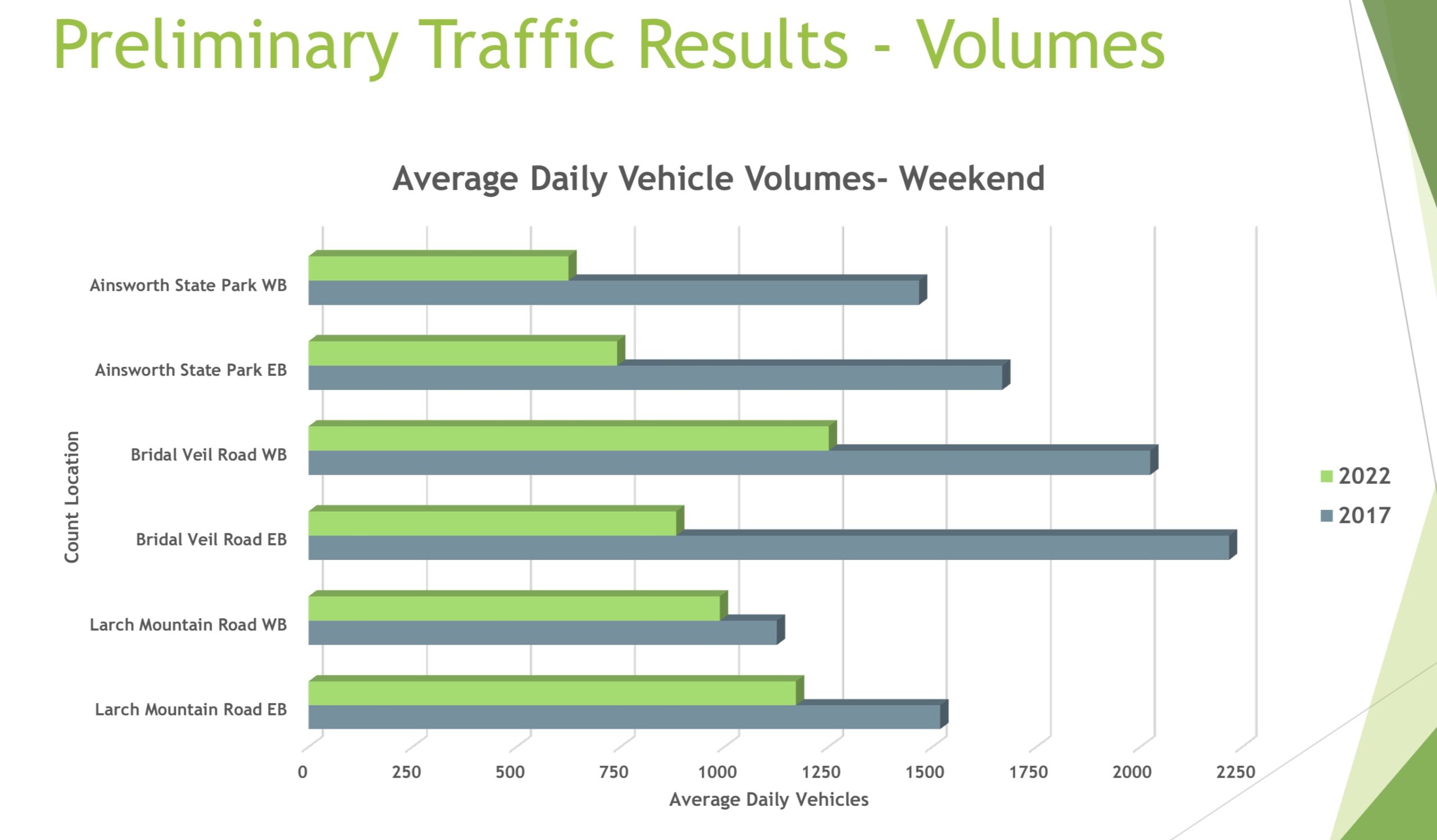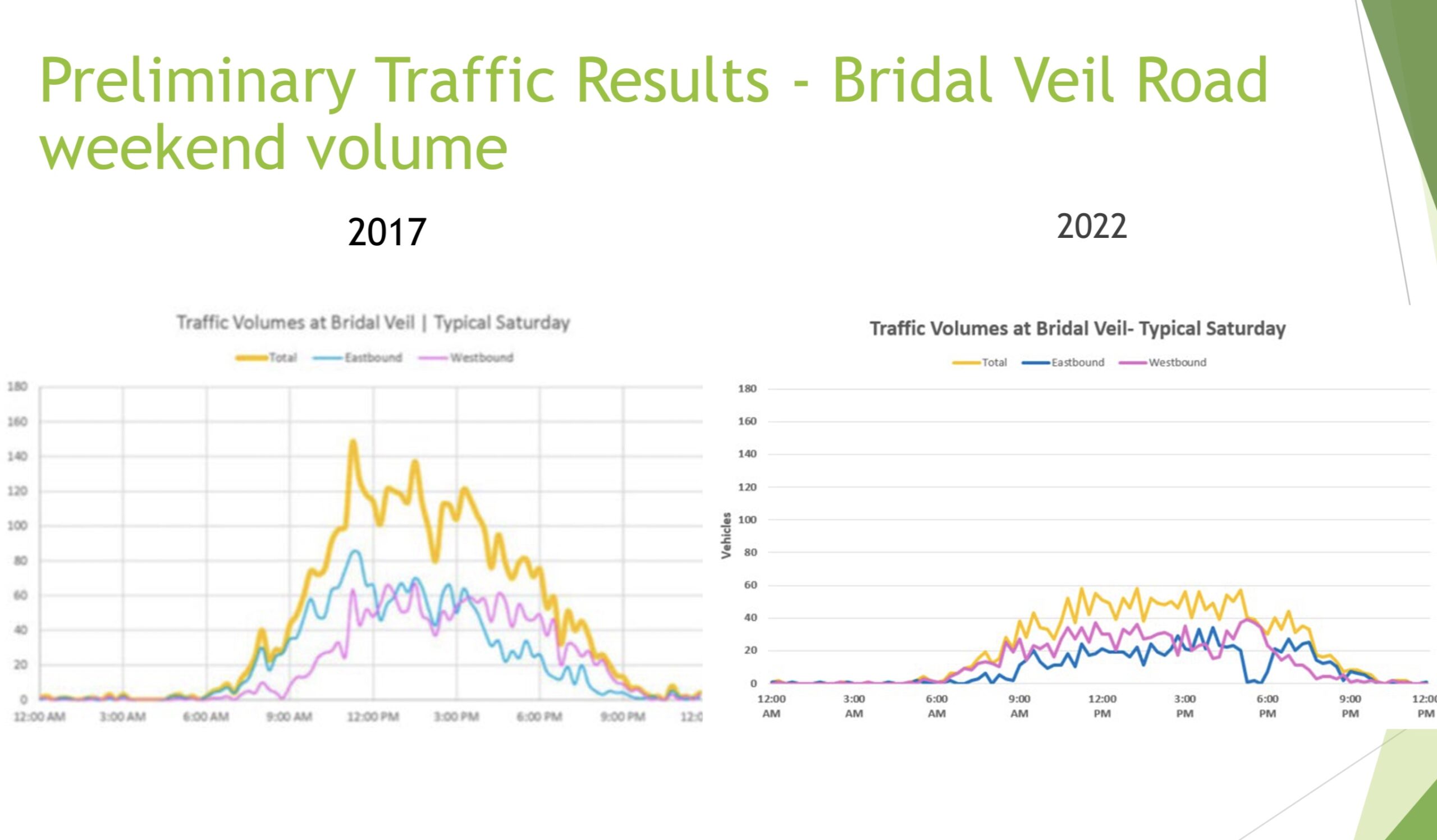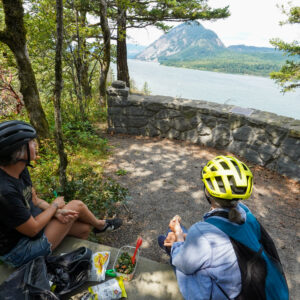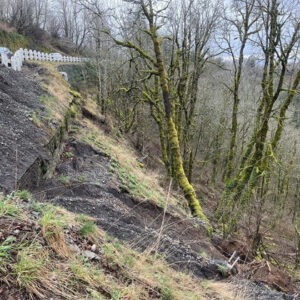
“I feel confident saying that we met our goals of improving visitor experience.”
– Terra Lingley, ODOT
State of Oregon officials say a permit system created to reduce car use in the Columbia River Gorge this past summer was a success and is very likely to return in 2023.
The timed-access permit system was required for entry into an approximately nine mile stretch of the Historic Columbia River Highway between Vista House and Ainsworth State Park from May 24th to September 5th. The permits were free at staffed kiosks, but those who got them online were charged a $2 fee. People who used transit or bicycles to access the highway did not need a permit.
The system was implemented to reduce congestion along the popular “Waterfall Corridor.” A draft evaluation of the program was shared at the September 15th meeting of the Historic Columbia River Highway Advisory Committee.
Oregon Department of Transportation Columbia River Gorge National Scenic Area Coordinator Terra Lingley told the committee that about 130,000 permits were issued. In a presentation to committee members, Lingley said there was a mix of feedback to the program, but overall it worked well. “I feel confident saying that we met our goals of improving visitor experience,” she said.
While there was some confusion about the program and a lot of drivers were rude to State Parks staff, ODOT logged numerous comments from visitors who liked the new system. The permit system received an average of four out of five stars across over 1,700 ratings on Recreation.gov. Car traffic overall was also significantly reduced over previous years.
According to ODOT data, the average daily traffic this year compared to 2017 was much lower. In the eastbound direction at Bridal Veil Falls, for example, there were about 2,200 cars each day in 2017. That number fell to about 850 cars this year. And because a limited number of permits were released each hour, the system leveled out the number of car-using visitors and reduced the problematic peak of years past (see graphics above).
Oregon Parks and Recreation Division Manager Clay Courtright echoed Lingley’s perception of how it went. “I think folks embraced it to a large degree. It did reduce traffic and people were largely happy,” While Courtright said some people were angry that they had a permit but could still not find parking (the permit didn’t guarantee parking), he said, “For the people that could find parking spaces, there was a resounding and repeated message that the visitor experience was very good.”
Courtright and Lingley shared stories about people who disobeyed the rules and/or who were rude to permit staff. “It was rough on staff,” Courtright said. And Lingley said a gas station employee in Cascade Locks was telling people to lie about their plans. Since it’s a state highway, Lingley said, they weren’t allowed to prohibit through traffic. “So some folks would say they just wanted to drive through, but we’d see them park and visit.”
“I feel like I owe Parks staff a free therapy session,” Lingley added.
The program cost the state around $1 million for the three months. Lingley said that’s not sustainable and they’ll need to find a dedicated funding source in the future.
Look for improved shuttle and transit service next year along with a few other tweaks. For more on the program, check out ODOT’s website.









Thanks for reading.
BikePortland has served this community with independent community journalism since 2005. We rely on subscriptions from readers like you to survive. Your financial support is vital in keeping this valuable resource alive and well.
Please subscribe today to strengthen and expand our work.
Not sustainable? I would laugh if I didn’t have to cry.
I’ll quote some reasons to do this from the article when the program first came to light:
So now ODOT can’t spare a million dollars for these outcomes? Fire & Rescue response and police enforcement are suddenly FREE now? Those things don’t need to be factored into the cost savings this program provides? Nope… now it’s merely a budget line item that’s “not sustainable” and thus ripe for cuts when ODOT needs to free up money to build freeways or just to bolster some ODOT manager’s profile for being effective at “cutting costs” without affecting freight somewhere.
Hi Mick O. You need to understand the context of this quote.
First, ODOT is doing amazing stuff in the Gorge. You shouldn’t paint entire agency with one brush, because the Gorge Scenic Area folks are actually trying to do really good stuff (which unfortunately gets stymied by top brass, but I digress) with this permit thing and the Historic Highway Trail project — which is one of the coolest projects in the country right now!
And I think what Lingley was saying here reflects that this was a pilot project. It’s probably relatively unknown in the greater ODOT machine (hasn’t been to the OTC yet, for one thing) and this was done as a test. I have very little doubt that once Lingley completes a full evaluation of the program (this was just a quick, prelim thing she shared) and runs it through the proper channels, the money will be found to keep it going. I could be wrong, but that’s my hunch right now.
I agree it’s cool, very cool. We’re on the same page there. But “stymied by top brass” is exactly what I am complaining about. Those specific outcomes I quoted above are exactly what ODOT should be spending money on. They have a “funding source” for making people safer called ODOT’s operating budget. The very idea that spending money on safety is “not sustainable” unless it generates revenue is the pure, uncut reason why ODOT is such a dreadful entity.
Regardless of the context, the idea that this is in ANY way “not sustainable” is infuriating, and it is tragic that people trying to do good work at the agency are forced to proactively think that way. THAT is what I am lamenting here.
I suspect Terra was just raising that issue so listeners know that it is something they can help support as budgets are identified for future operations. There needs to be a process to get that funding. It’s just a fact of agency budgeting. I agree with Jonathan.
It’s a good start! When I rode out there a couple of times this summer, it felt so much safer, not just because there were fewer cars, but those cars drove more safely. Maybe because they’re feeling aware that driving is a privilege? In any case, not waiting in a line of polluting fumes to see the falls was fabulous.
Funny story, I met some e-bikers out there who were tourists from another state and when I mentioned that the permit system had really eased traffic, they were stunned. It felt like a lot of traffic to them and they were pretty unnerved because there were no bike lanes or wide shoulders.
I dream of a day when that stretch is closed to cars completely and permits to drive in certain areas becomes commonplace.
This is all it take to reduce car usage? Can we do this state wide? Forget diverters lets permit every car trip. I know it’s not feasible it’s just astounding how easy it is to reduce trips if ODOT wants to.
It also took a tremendous amount of buy-in from State Parks — a good partnership.
I mean probably they should just change this, or implement a toll system overall (dare I say congestion pricing?!?!)
Road tolls on the old highway? Paid parking at Multnomah Falls?
Wikipedia says Multnomah Falls gets “over 2 million visitors” each year. Assume nearly all of them arrive in cars, and further assume 3 people per car … that’s nearly 700,000 cars per year. A $2 per car parking fee would raise more than enough to support the program.
Nice summary. Seems like a good start. Is there a similar overview of how the Multnomah Falls program has been working? (now in 2nd, or 3rd year?)…nevermind, both were in the presentation on their website !!
As someone who volunteered at the Vista House and was unofficially one of the spokespersons for the program (the most asked question was probably about the pass system, not the Vista House) I’d say it was a resounding success. A lot of people liked the Waterfall Trolley and other alternative methods of transit. Sure there were a few jerks that were angry about the timed pass system, but most people were understanding and liked the pass system and the alternatives we presented.